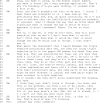'Your comments are meaner than your score': score calibration talk influences intra- and inter-panel variability during scientific grant peer review
- PMID: 28458466
- PMCID: PMC5407376
- DOI: 10.1093/reseval/rvw025
'Your comments are meaner than your score': score calibration talk influences intra- and inter-panel variability during scientific grant peer review
Abstract
In scientific grant peer review, groups of expert scientists meet to engage in the collaborative decision-making task of evaluating and scoring grant applications. Prior research on grant peer review has established that inter-reviewer reliability is typically poor. In the current study, experienced reviewers for the National Institutes of Health (NIH) were recruited to participate in one of four constructed peer review panel meetings. Each panel discussed and scored the same pool of recently reviewed NIH grant applications. We examined the degree of intra-panel variability in panels' scores of the applications before versus after collaborative discussion, and the degree of inter-panel variability. We also analyzed videotapes of reviewers' interactions for instances of one particular form of discourse-Score Calibration Talk-as one factor influencing the variability we observe. Results suggest that although reviewers within a single panel agree more following collaborative discussion, different panels agree less after discussion, and Score Calibration Talk plays a pivotal role in scoring variability during peer review. We discuss implications of this variability for the scientific peer review process.
Keywords: collaboration; decision making; discourse analysis; peer review.
Conflict of interest statement
Conflict of interest statement. None declared.
Figures






Similar articles
-
Panel discussion does not improve reliability of peer review for medical research grant proposals.J Clin Epidemiol. 2012 Jan;65(1):47-52. doi: 10.1016/j.jclinepi.2011.05.001. Epub 2011 Aug 9. J Clin Epidemiol. 2012. PMID: 21831594
-
Low agreement among reviewers evaluating the same NIH grant applications.Proc Natl Acad Sci U S A. 2018 Mar 20;115(12):2952-2957. doi: 10.1073/pnas.1714379115. Epub 2018 Mar 5. Proc Natl Acad Sci U S A. 2018. PMID: 29507248 Free PMC article.
-
Involving Patient Partners in the KRESCENT Peer Review: Intent, Process, Challenges, and Opportunities.Can J Kidney Health Dis. 2022 Nov 15;9:20543581221136402. doi: 10.1177/20543581221136402. eCollection 2022. Can J Kidney Health Dis. 2022. PMID: 36406869 Free PMC article.
-
Science peer review for the 21st century: Assessing scientific consensus for decision-making while managing conflict of interests, reviewer and process bias.Regul Toxicol Pharmacol. 2019 Apr;103:73-85. doi: 10.1016/j.yrtph.2019.01.003. Epub 2019 Jan 8. Regul Toxicol Pharmacol. 2019. PMID: 30634024 Review.
-
What do we know about grant peer review in the health sciences?F1000Res. 2017 Aug 7;6:1335. doi: 10.12688/f1000research.11917.2. eCollection 2017. F1000Res. 2017. PMID: 29707193 Free PMC article. Review.
Cited by
-
Community review: a robust and scalable selection system for resource allocation within open science and innovation communities.F1000Res. 2023 Apr 18;11:1440. doi: 10.12688/f1000research.125886.2. eCollection 2022. F1000Res. 2023. PMID: 38283124 Free PMC article.
-
The role of author identities in peer review.PLoS One. 2023 Jun 21;18(6):e0286206. doi: 10.1371/journal.pone.0286206. eCollection 2023. PLoS One. 2023. PMID: 37342992 Free PMC article.
-
Biomedical research grant resubmission: rates and factors related to success - a scoping review.BMJ Open. 2024 Nov 14;14(11):e089927. doi: 10.1136/bmjopen-2024-089927. BMJ Open. 2024. PMID: 39542492 Free PMC article.
-
Laughter and the Chair: Social Pressures Influencing Scoring During Grant Peer Review Meetings.J Gen Intern Med. 2019 Apr;34(4):513-514. doi: 10.1007/s11606-018-4751-9. J Gen Intern Med. 2019. PMID: 30604119 Free PMC article. No abstract available.
-
Perspective commentary from the Society for Pediatric Research: supporting early-stage pediatric physician-scientist success.Pediatr Res. 2020 Apr;87(5):834-838. doi: 10.1038/s41390-019-0745-5. Epub 2020 Jan 2. Pediatr Res. 2020. PMID: 31896124 No abstract available.
References
-
- Aronson E, et al. The Jigsaw Classroom. Beverly Hills, CA: Sage Publishing Company; 1978.
-
- Asch SE. Effects of Group Pressure on the Modification and Distortion of Judgments. In: Guetzkow H, editor. Groups, Leadership and Men. Pittsburgh, PA: Carnegie Press; 1951. pp. 177–90.
-
- Asch SE. Opinions and Social Pressure. Scientific American. 1955;193:33–5.
-
- Baker M, et al. The Role of Grounding in Collaborative Learning Tasks. In: Dillenbourg P, editor. Collaborative Learning: Cognitive and Computational Approaches. Oxford: Pergamon; 1999. pp. 31–63.
-
- Barron B. Achieving Coordination in Collaborative Problem-Solving Groups. The Journal of the Learning Sciences. 2000;9(4):403–36.
Grants and funding
LinkOut - more resources
Full Text Sources
Other Literature Sources

